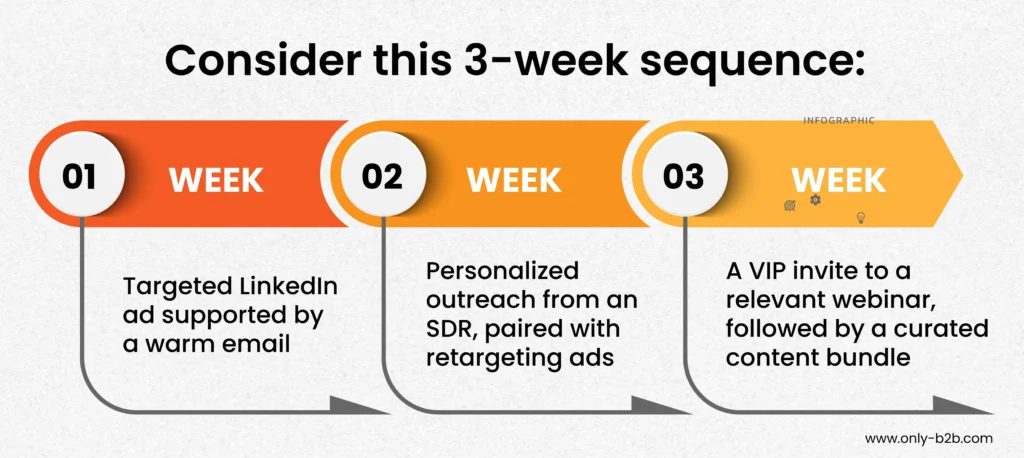Consider this: companies often build target account lists of 300 to 500 decision-makers and procurement heads each quarter. But if only a fraction of these accounts, say 10 to 15%, receive timely and relevant engagement, meaning most of your pipeline potential remains untapped.
Despite sophisticated tech stacks and access to firmographic data, outreach often feels fragmented or impersonal.
Decision-makers push aside irrelevant emails. Ads fail. SDRs miss the buying window. Why? Because your teams aren’t on the same page on when and how to engage.
This is where Account-Based Engagement becomes important.
What is Account-Based Engagement (ABE)?
Table of Contents
ABE is the collaborative approach where marketing, sales, and customer success teams work together to engage high-value accounts with personalized content and interactions.
It focuses on deepening relationships with a select group of accounts that are most likely to drive significant revenue.
ABE enables you to orchestrate consistent and personalized touchpoints across email, social, events, ads, and sales outreach.
The goal is to drive real engagement, build trust, and move accounts through the buying journey.
The 6 Pillars of a High-Performing ABE Strategy?
1. ICP & Intent-Based Account Selection
Many teams start with enthusiasm and end up peeling only the upper layers such as account size or industry. They miss the deeper layer of buyer behavior, and the resulting outreach lands flat or never reaches the right stakeholders.
Effective ABE begins with deep behavioral targeting. You should go beyond static profiles and use intent data to reveal which accounts are actively researching your solutions.
Use tools like Bombora or Cognism to understand this buyer interest, enabling you to prioritize with purpose.
Let’s say a VP of Procurement explores articles on data governance. That subtle signal, captured in your intent data, could be your cue to engage before competitors do.
2. Unifying Sales and Marketing (“Smarketing”) Goals
Even seasoned teams can fall into the trap of misalignment when marketing pushes content while sales waits for “sales-ready” leads that never arrive. The disconnect leads to frustration, delays, and missed opportunities. Your ABE will only succeed when both teams co-own revenue. What does that mean?
It means teams agree on what qualifies as engagement and commit to timely, coordinated follow-ups.
Picture this: three decision-makers from a target account visit your pricing page within 48 hours. That is not just interest, that is urgency. A shared SLA (Service-Level Agreement) ensures sales reaches out within the next day.
With regular syncs and unified dashboards, marketing and sales don’t just align, they move in sync, converting accounts.
3. Hyper-Personalized Campaign Crafting
Pushing the same messaging to every CFO, CTO, or VP assuming they are the same will not resonate. These missteps dilute your impact and disengage the very people you’re trying to convert.
Personalization means understanding the individual’s role, challenges, and buying context, and reflecting that in every interaction. When done right, your message feels like a helpful nudge, not a sales push.
For example, a VP of Finance at a retail company might respond to ROI-driven messaging, while a CTO at a SaaS firm looks for scalability and security. These nuances matter, and they compound your chances of building trust.
4. Coordinating Multi-Channel Touchpoints
Too often, ABE efforts collapse into isolated actions. One team sends an email, another runs LinkedIn ads, and someone else makes a cold call, all without context or timing.
Engagement should not be noise. It should be meaningful communication. This requires sequencing interactions across multiple channels in a way that feels natural and delivers your value proposition.

Each touchpoint builds upon the last, creating a cohesive, memorable experience.
5. Account-Level Engagement Measurement
Chasing vanity metrics like email open rates and MQL counts may feel productive, but they rarely tell the full story.
What truly matters is who within the account is engaging, how deeply, and what happens next.
Account-based metrics such as the number of active stakeholders or time spent engaging with high-intent content offer a clearer view of buying readiness.
When you shift your measurement lens from leads to accounts, your strategy becomes more informed, more precise, and far more effective.
6. Iterative Optimization
It’s tempting to treat ABE like a one-and-done campaign. You build it, launch it, and hope it delivers. But ABE is a dynamic system that thrives on feedback.
Success comes from reflection and iteration. After every campaign, review what worked: Which accounts progressed? What content resonated? Which touchpoints fell flat?
Make note of those learnings and build your next move. Over time, your playbook will evolve from theory to a proven framework, one that is rooted in data, agility, and a deep understanding of your buyers.
Quantifiable Benefits of Account Based Engagement (ABE)

When executed thoughtfully, ABE offers numerous benefits that contribute directly to revenue.
Dramatically Improved ROI
According to Forrester, 87% of marketers using account-based models report higher ROI. That is because ABE reduces waste by focusing only on accounts that matter.
Accelerated Sales Cycles
Personalized, multi-threaded engagement means less time convincing and more time closing.
Higher Customer Lifetime Value (CLV)
ABE doesn’t stop at the sale. By continuing to engage and support your high-value accounts post-sale, you get long-term loyalty and expansion.
Radical Sales and Marketing Alignment
Shared metrics and coordinated actions foster trust, accountability, and consistent performance.
A Solution to Common Friction Points
ABE eliminates guesswork, reduces internal conflict, and empowers both marketing and sales to work toward a shared goal: real, lasting customer relationships.
How to Launch Your ABE Program: A 5-Step Quick-Start Guide
Step 1: Define Your ICP and Build Your Target Account List
Start with data. Use historical success patterns, intent signals, and fit indicators to identify your most promising accounts. Remember: fewer, better targets often outperform long, unfocused lists.
Step 2: Forge Your Sales and Marketing Alliance
Co-create the strategy. Agree on goals, timelines, and definitions. Build shared dashboards and keep the dialogue flowing. ABE only works if both teams pull together.
Step 3: Map Your Content and Messaging
Different personas need different stories. Build content that speaks to their specific pain points, questions, and stage in the buying journey. Then map that content to your engagement plan.
Step 4: Choose Your Tech Stack
Integrate tools across:
- Data: Bombora, Cognism
- Engagement: Outreach, LinkedIn, Terminus
- Measurement: Factors.ai, HubSpot
Make sure these tools work together to provide unified account insights.
Step 5: Launch, Measure, and Iterate
Don’t wait for perfection. Start small with a pilot group. Track engagement, learn from anomalies, and refine. With each iteration, you’ll get sharper and more impactful.
Conclusion: The Future of B2B is Engagement
The market is saturated. How well you connect makes all the difference. It’s not about doing more. It’s about doing it better, with empathy, intent, and orchestration.
In an era dominated by AI and automation, human-centric, personalized engagement is your most powerful differentiator.
At Only B2B, we help B2B companies bring their ABE strategies to life with intent data, precision targeting, and multichannel execution that delivers. Let’s move from theory to results and make it happen.

Vikas Bhatt is the Co-Founder of ONLY B2B, a premium B2B lead generation company that specializes in helping businesses achieve their growth objectives through targeted marketing & sales campaigns. With 10+ years of experience in the industry, Vikas has a deep understanding of the challenges faced by businesses today and has developed a unique approach to lead generation that has helped clients across a range of industries around the globe. As a thought leader in the B2B marketing community, ONLY B2B specializes in demand generation, content syndication, database services and more.





